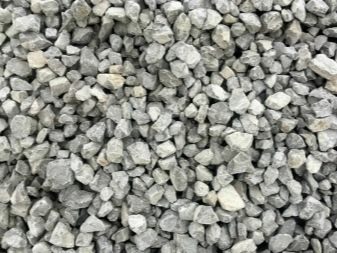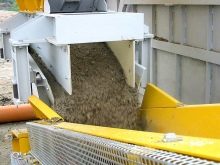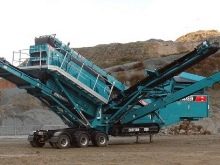What are screens and how to choose them?

The screen is a system of special grids designed to calibrate bulk materials by size of fractions. Typically, abrasive building materials, minerals, some types of plant materials, as well as solid recyclables are subjected to screening.
According to rough estimates, each year around the world, about 2 billion tons of bulk materials pass through screening.


What it is?
Screeners are one of the types of container equipment. They are in demand everywhere in the mining industry. Thanks to its simple design, the screen separates bulk materials with high precision into several fractions - for example, sand and crushed stone. Today, screening is recognized as the simplest and most versatile solution for screening quarry and mining materials ranging from 1 to 300 mm.
The separation of bulk materials has an important technical purpose. It is used when it is necessary to obtain a homogeneous raw material of a given range of values - that is, the options "no less than", "no more than" or "from and to".
In the simplest version, as a result of sorting, two fractions are obtained - large, remaining on the surface, and small, crumbling down through the holes in the grate.



For the organization of screening, specialized equipment is used - screens. In the mining industry, the most widespread are vibratory units with several scattering sieves located in a box accessible from the material discharge side. The individual sieves are placed one under the other, ranging from coarse to fine. The vibration of such a device is provided by a spring base. The main structural element of the screen is a sieve. The purpose of the metal grid is to separate particles depending on their size. In the course of screening, the smallest fragments of the fraction are sifted out and go down, while the larger ones remain on the surface of the grate.
The main indicator of a machine's performance is its performance. This parameter depends on the following factors:
- design features of the device and its shape;
- preset screening speed;
- the thickness of the sorting material, as well as the degree of its moisture.


Applications
Screening, like many other manipulations associated with sorting into fractions, is used to solve a number of important tasks.
- In the mining industry - to separate from a large volume of crushed rock separate fractions of a given size, which are required to perform certain technological manipulations or return to subsequent crushing.
- In the production of building materials —To distinguish goods of a certain degree of size. For example, to obtain a fine fraction of construction crushed stone or abrasives.
- In industry - for sorting material of various sizes into separate streams, taking into account technological requirements and their further processing. This method is used in the case of enrichment of diamond ores and ores of rare earth metals. The technique is in demand in the deep processing of solid household and industrial waste.
- In agriculture - for sifting the soil. The machine is used for sorting wheat, corn, and compound feed. The technique is in demand for working with soybeans, rapeseed and other oilseeds and tobacco.


Views
Modern manufacturers offer a wide range of screens. All of them differ in design features, scheme of work and functional purpose. Each of them has its own universal characteristics. There are several reasons for classification.



By the way the material is moved
Depending on the method of moving materials and the parameters of movement of the main functional organ, there are several types of screens. They may be as follows
- Fixed - these include arc, conical and grate.
- Movable - include roller, chain, as well as vibration excitation and gyratory models.
- Rotating - drum-type screens.
- Hydraulic - the movement of matter in them is carried out through the aqueous medium.
A distinctive feature of static screens is the strength of fixing the screen in one position. In partially mobile equipment, sorting is performed in roller units. Their scattering surface is in the form of disks fixed on rolls moving in the direction of raw material supply. Such screens are in demand when processing and screening coal, limestone and other non-metallic rocks before being sent to a crusher.


The movable type devices are flat. These units produce symmetrical longitudinal oscillatory movements. Depending on the model, they can be inclined, slightly inclined or horizontal. Screens can be inertial and self-balancing. The first ones provide for special vibration drives, which transmit the force of the orbital type in the vertical direction. For the most efficient movement of raw materials, the equipment box is fixed at an angle of 7-15 degrees relative to the horizon.
Self-balancing screens are equipped with a pair of vibration drives. They function in antiphase and form a direct linear movement of the box. This type of screens maximizes screening efficiency and requires less headroom.
At the same time, such equipment consumes 15-20% more electricity.

By the shape of the working surface
Taking into account the geometry, all equipment on the market can be drum, flat or arc. Drum sets have the highest productivity. Structurally, they represent a drum fixed at an angle; its internal blocks are made of a metal mesh. Such units are ubiquitous for dividing bulk raw materials into separate classes.
The cylinder is started by starting the engine. Fractions are loaded through a special funnel. After that, part of the product ends up in the hopper, part falls into the holes and is sent for further processing.



By the location of the screening surface
According to the location of the sieve, all screens are divided into inclined and horizontal screens. There are many types of screening surfaces of different shapes. The most widespread are lattices with rectangular and square cells, less often round ones are used. Sieves are classified as high-wear consumables, therefore they are made from materials of increased resistance - steel and special varieties of polyurethane foam.
According to the size of the sorted fractions, the screens can be divided into devices for superfine, fine, fine, and also coarse sorting:
- to isolate the largest fraction, grate sieves with a cell size of the order of 100-300 mm are used;
- for medium - perforated surfaces 25-60 mm;
- for small - models of sieves with perforation of 6-25 mm are offered;
- for thin - the equipment is completed with a sieve with holes of 0.5-25 mm.


Especially fine calibration is in demand in the production of abrasives, grinding powders and in particle size analysis. Such machines are equipped with sieves up to 0.05 mm in size.In order to increase the productivity of screening ores containing fine-grained and clay impurities, wet screening is often used. In this case, water is supplied to the grate. With this approach, there is a need for subsequent dehydration of the material.
A separate group is made up of high-frequency installations, in which particles are separated by an air flow. A similar technique was often used in the countryside, sifting corn, wheat, and seeds in the wind. In this case, the husk is carried away by air masses, and the grains fall into the box. Installations operating on this principle are centrifugal and gravitational.
Contaminated air streams must be cleaned using a filter system and cyclones.

Popular manufacturers
Equipment of various companies is offered on the market, the most demanded are:
- HITACHI;
- TEREX;
- LIMING;
- SANDVIK;
- ATLAS COPCO;
- POWERSCREEN;
- FABO;
- TEREX-FINLAY;
- MEKA.



The greatest demand all over the world is used by the equipment of European enterprises. For example, in Sweden, screens are manufactured by Sandvik, a recognized market leader in equipment for the mining and construction industry. Mobile screens from this brand are characterized by increased productivity, reliability and quality.
In the UK, screens are manufactured at Extec's manufacturing facilities. They manufacture all units with innovative developments on the most advanced equipment. Another British company, Powerscreen, has been manufacturing reliable equipment since 1966. Terex equipment is the most popular in our country.



Selection Tips
The choice of a screen seems simple only at first glance; in fact, it has many subtleties and nuances. To acquire the optimal model, you need to decide on the following basic factors:
- screening technological tasks - preparatory, auxiliary, independent, dehydrating;
- equipment performance;
- sieve area - to be determined taking into account the given productivity and sorting efficiency;
- the size of the screening raw materials;
- humidity of the processed material;
- sorting type - dry or wet;
- the number of tiers - depending on the tasks for sifting;
- vibration parameters - circular, elliptical, linear;
- frequency and amplitude of vibrations of the roar;
- equipment placement option - suspended, supporting, mobile.
The shape of the lattice cells plays an important role. Their choice depends on the type of material to be sorted. If its particles are of the correct shape, round holes will be the best solution. In all other situations, oblong or quadrangular are used.

The efficiency of material processing depends on the structure of the screening surface.
- Woven - made from a rod or wire with a highly alloyed composition. They are in demand when sorting coal, building materials and seeds.
- Perforated - made of stainless steel, can withstand increased loads. They are used in the field of water treatment and water purification.
- Polyurethane - a good alternative to metal screens, useful for filtering sand, limestone and coke.
- Grizzly grates represent a system of cascading gratings. Easily cope with sieving large pieces of limestone and dolomite.
- Self-cleaning - designed to remove silt particles and work with clay.
- Slotted - help in sorting liquid and gaseous media.









The comment was sent successfully.